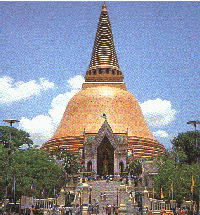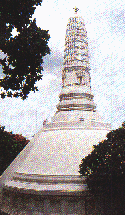
Wat Phra Pathom Chedi in Nakhon Pathom

Pra Pathom Chedi today, built over ancient chedi |

Pra Pathom Chedi replica of underlying ancient chedi |
The chedi to the right is of merged Indian and Khmer styles, and is now covered over by the new chedi. The replica was created under King Rama 4 during first phase of "reconstruction", and stands in the south of the complex.
The Phra Pathom Chedi, located about an hour from Bangkok by bus, may house the oldest Buddhist structure in Thailand, dating a little more than 2000 years ago. You cannot see the original chedi because it has been encased by the new chedi and nobody is allowed inside except the birds who can fly thru the holes. Thus, it's not like travelling to Egypt or Greece or Rome. However, some ornaments, statues and other objects from different periods are on display along the outside of the chedi as well as at a nearby museum. (Many others were carted away by various military conquests, mainly by the Burmese and to a lesser degree by the Khmers over the centuries.)
History
By the time Buddha died (about the same time Greek civilization was establishing Western Civilization as we know it), Buddhism had already spread all over central India, despite the Hindu military conquest against this powerful force. King Asoka, who inherited the throne and had a change of heart, reversed this revolution for a convergent evolution/assimilation, and sent missionaries to other lands to spread Buddhism further. One of the four great kingdoms in the region to which the missionaries went to spread Buddhism (and Buddha's ashes and other holy relics) was Suvarnabhumi, according to what historical records have survived the times, and the majority of scholars think that Nakhon Pathom was the capital, based on geographical reports from different explorers (Indian, Chinese, others), the abundance of the oldest Asoka-style relics and large ruins there, and the first rendition of the above Chedi as a stupa constructed in the third or fourth Buddhist century (200 to 100 years before Christ) which clearly stood out in size for its day. Indeed, according to some accounts, some of Buddha's ashes were enclosed in the first temple and hence may be enclosed within the current structure.
In India, Buddhism became banned when a Hindu kingdom expanded throughout India, and Buddhist monks were summarily executed en masse. Later, in practice, Hinduism and Buddhism merged. Buddhism was never suppressed in Siam, but was introduced and has been the predominant way of life for millenia.
Nakhon Pathom was a thriving cultural center for a millenia, and the stupa was restored several times over this period, along with many other stupas and temples. The latest restorations before the modern reconstruction were of Cambodian style, as the Khmers were overlords of the region in the last centuries before the downfall of Nakhon Pathom city.
In 1057, King Anurutha of Burma came with his army to attack the town, and reportedly took all its inhabitants back to Burma (e.g., as slaves). It is also reported that he tried to locate and dig up the Buddha ashes and relics, though there is no recording that such a prize was found and brought back to Burma. Other reports say that the remaining inhabitants fled and started Ayutthaya, which would eventually become the predominant cultural center of Siam for several hundred years until another Burmese invasion in the 1767 A.D. destroyed Ayuthaya.
In 1057, Nakhon Pathom was deserted, and it was eventually overcome by jungle. Some of its inhabitants reportedly returned but then abandoned the city due to flooding by a nearby river. (The area is still prone to flooding and swampiness.)
Phra Pathom Chedi was left to decay in the jungle without care or attention, until Buddhist monks came to reside there during the reign of King Rama 2 in the early 1800's A.D. During the reign of King Rama 3, his brother Prince (later King) Monghut, while a member of the Buddhist priesthood, went several times on pilgrimage to the stupa. On his accession to the Throne, King Monghut (Rama 4) began a restoration process by building an enormous Chedi over the existing one, including an entire complex with four chapels, numerous sculptures and castings of Buddha (including the immense Reclining Buddha), displays of ancient artifacts, caves into the base of the structure where one can go meditate and pray, and a nice garden sanctuary.
King Rama 4 did not live to see completion of the temple, and the work was carried on by King Chulalongkorn (Rama 5). In addition, King Rama 5 had the jungle pushed back and an entire city built around the Chedi.
Bus and train services run between the Nakhon Pathom Chedi and Thonburi (the train station on the river, and the bus station not far from the Chao Phraya River when you exit Bangkok proper).
Also worth visiting is the Human Imagery Museum along this highway about halfway from Thonburi to Nakhon Pathom, which presents elements of Thai culture using wax figures.
 > Domestic Travel for Leisure > Nakhon Pathom Chedi
> Domestic Travel for Leisure > Nakhon Pathom Chedi
Additional, children pages of this current parent page:
Nakhon Pathom Chedi :
Copyright 1999 -
2025 by Mark Evan Prado, All Rights Reserved.
Notably, I get quickly notified of copies of tracts by the CopyScape / CopySentry automatic search engine & notifier.
Short quotes are often OK and can be approved, if there is a clear reference and web link back to my website from the quoted material, and if you send me a short message. I try to help people with good intentions, and try to help the world. Not thieves. Links back to this website are helpful for sustainable progress, thank you!
Please have honor and class by following intellectual property and internet protocols. Be a good kind of person in life.
|
Want to privately ask the Thailand Guru? Contact us.
|
|
Some of the services discussed on Thailand Guru are provided by our friendly staff in our 2 companies: |
|
|
Lucky Lion Pride Co., Ltd.
|
|
| DISCLAIMER: Although efforts have been made to ensure the information on this website was correct at the time of electronic publication, ThailandGuru and all its associates do not assume and hereby disclaim any liability to any party for any loss or damage caused by errors, omissions or misleading information resulting from negligence, accident or any other cause. If you choose to take any of this advice, it is at your own risk and no other entity's. ThailandGuru and its associates will take no responsibility. The only thing we guarantee is that our website information can take bandwidth, memory and/or disk space, at least temporarily. Guru is relative. | |
Menu: Site Map